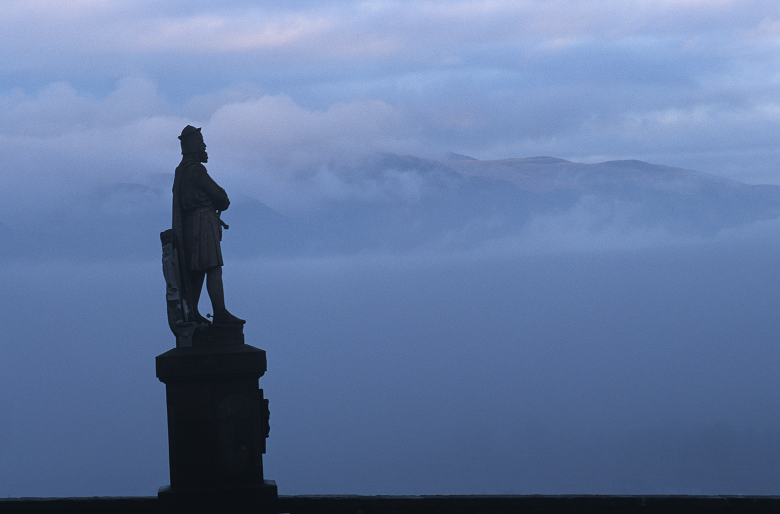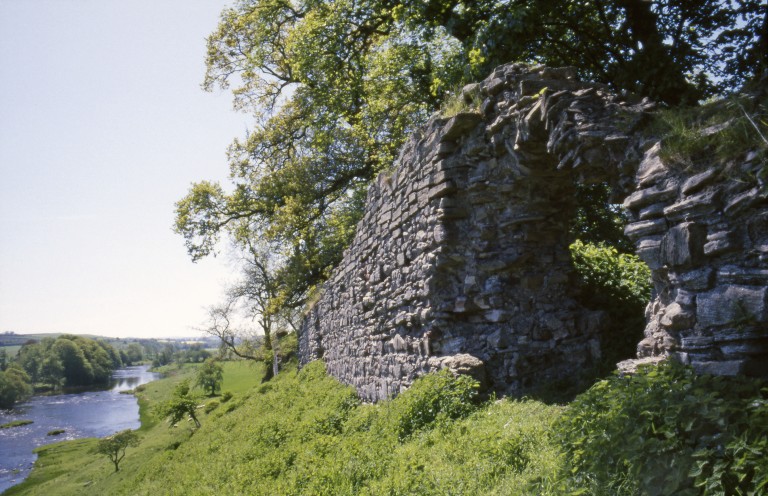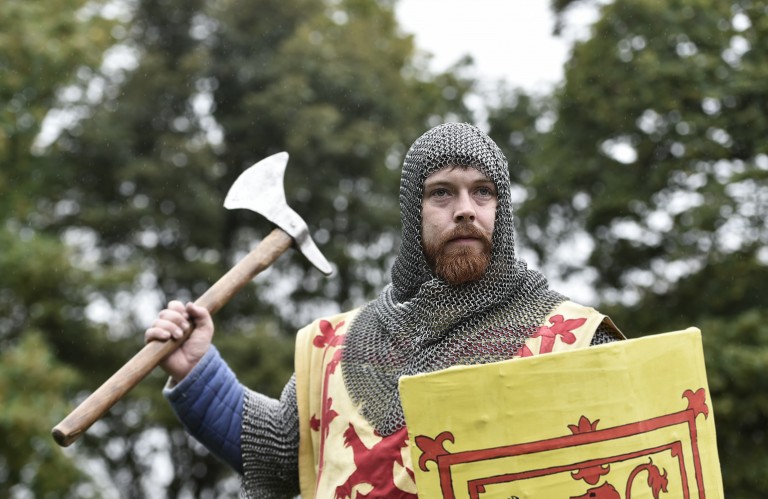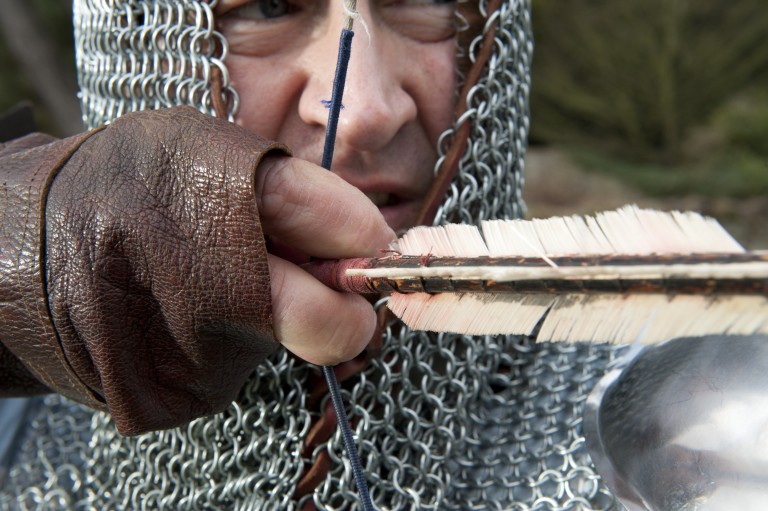The Battle of Bannockburn took place on 23 – 24 June 1314.
We pulled out some of the key facts from our Inventory of Scottish Battlefields to help you understand the events of this famous historic moment.
1. What was the Battle of Bannockburn?
The Battle of Bannockburn was a key battle in the Scottish Wars of Independence.
The battle was a continuation of King Robert I’s campaign to take control of the kingdom he had claimed in 1306.
King Robert I is probably better known by his stirring moniker, Robert the Bruce).
It gave him effective control over Scotland.

A statue of Robert the Bruce looking out from the esplanade at Stirling Castle
Who fought at Bannockburn?
Robert the Bruce’s Scottish army, including MacDonalds from Islay, fought King Edward II’s (mostly) English army, though Bruce also had Scottish opponents who fought with Edward.
Edward’s army also included a large body of Welshmen and a contingent of Irishmen under the command of the Earl of Ulster – who happened to be Bruce’s father-in-law.
Who won the Battle of Bannockburn?
Bruce’s forces overcame the much larger English army. Although the Wars of Independence continued for another fourteen years, this was a decisive blow against Edward II’s authority in Scotland.
While Bruce had, like William Wallace, been defeated by Edward I (known as “The Hammer of the Scots”), after Edward died in 1307 he made gains across Scotland.
He took Edinburgh Castle through a small party climbing up the Castle Rock and over the – then low! – battlements; and Roxburgh Castle in the Borders which was in a strategically important position.

Remains of Roxburgh Castle
By 1314 Bruce had Stirling Castle under siege, and a pact had been made that the castle would be surrendered to the Scots if the siege persisted until midsummer.
To prevent English relief forces arriving to break the siege, Bruce gathered a large army and had time to drill the schiltrons (compact groups of soldiers, often armed with pikes) into a high state of preparedness.
What happened at the battle?
Edward II drew up a larger army with knights, men-at-arms and archers before marching on Stirling from Falkirk.
The Scots had chosen a naturally defended position and dug pits filled with sharpened stakes to defend against a cavalry charge.
The initial fighting began when the English advance party came in sight of the Scots. Henry de Bohun (nephew of the vanguard’s joint commander) saw Bruce and charged towards him. Bruce avoided the attack and killed him as he rode past, the axe blow breaking the handle.

Re-enactor as Robert the Bruce holding his axe aloft
This incident, described by 14th Century Scottish poet John Barbour, was commemorated on the old Clydesdale Bank £1 note.
A small detachment of English soldiers attempted to reach Stirling Castle but were intercepted by the Earl of Moray’s schiltron and driven off.
Repeated charges failed to disrupt the close formation of pikemen. When Sir James Douglas appeared with a second schiltron, Moray’s group began advancing towards the English. The remaining forces broke, some heading towards Stirling and some back to the main army who had moved down onto marshland to the south-east of the castle for the night.
Never underestimate your opponent
It seems that Edward II’s plans were based around intercepting the Scottish army when they tried to escape the battle. Instead, Bruce’s men marched out of the shelter of nearby woods and began to move steadily forward.
The English army, despite its cavalry and greater numbers, were not prepared for battle. There seems to have been an assumption that the Scots wouldn’t fight, so the horseback charge was ineffective due to the lack of space and organisation.
The Earl of Gloucester argued with King Edward over tactics and the previous day’s losses. Gloucester later died on the battlefield, chronicled in Vita Edwardi Secundi (written by an unknown English medieval historian).
The lack of space and time before the armies met meant the English archers contributed very little to the battle. Once both sides were fighting in the same space, archers were not deployed. The advancing Scots drove the English back, enclosed by burns and bogs on both sides, so that the English lines began colliding with each other and eventually broke.

The archers were not deployed
The camp followers who were watching came running down the slopes to finish off armoured soldiers stuck in the mud. The soldiers initially thought they were fresh reserves, so when they started attacking, panic in the English ranks increased yet further.
The English army dispersed. Pursued by Sir James Douglas, Edward II tried to head for Stirling but then turned towards Falkirk and Linlithgow, making his way to Dunbar before travelling further south by boat until he could reach a ship.
Most of the English army fled and were taken prisoner, including the Earl of Hereford who was taken prisoner at Bothwell Castle. Some apparently drowned in the River Forth.
2. Why is Bannockburn famous?
Bruce had defeated the English, claimed Stirling Castle, and established himself as King. His Scottish opponents had to leave the country.
The Lord of the Isles was now a MacDonald and a supporter of Bruce, displacing the English-supporting MacDougalls, meaning there was less of a threat from the Western Isles. Longer term, the result of the battle led to recognition of the kingdom of Scotland by Pope John XXII.
As a decisive battle in the First Scottish Wars of Independence, Bannockburn became a major element in the definition of Scotland as an independent entity, and a rallying point for Scottish nationalist groups.

Statue of Robert the Bruce, by Pilkington Jackson, at Bannockburn.
Cultural impact
The battle is mentioned in a wide ranges of poems, ballads and songs, the most famous examples being Scots Wha’ Hae and Flower of Scotland.
Although William Wallace died nine years before the Battle of Bannockburn took place, the 1995 film Braveheart ends with Robert the Bruce evoking his memory before leading Scotland to victory. Whilst this film is famously loose with the historic facts, in its own way it helped cement Bannockburn in the minds of a global audience as the final victory in the Wars of Independence.
3. What’s Bannockburn like today?
Named after the Bannock Burn, a stream that flows into the River Forth, Bannockburn is now part of Stirling, having grown from a village and joined up with the city over the last few centuries.
The land was purchased by the Earl of Elgin (the head of the Bruce family) in 1932 and centred around a flagpole that was erected in 1870 to commemorate the battle.

Oblique aerial view of Bannockburn Heritage Centre
The National Trust for Scotland opened a visitor centre at Bannockburn in 1967, located in the area of events from the first day of the battle.
In 2014, to mark the 100th anniversary of the battle, we undertook a joint project with NTS (with support from Heritage Lottery Fund) to create a state of the art immersive experience of the battle.
From the battlements of Stirling Castle you can see Bannockburn, and if a guide is available they may be able to point out to you the locations of the battle (though there is some dispute over where the events of the second day took place).
We also run dedicated tours around the anniversary.

